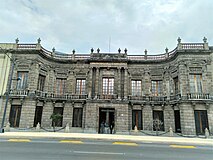Manuel Tolsa
Manuel Vicente Agustín Tolsá y Sarrión (in Valencian: Manuel Tolsà Sarrion. Enguera, Valencia, May 4, 1757 - Mexico City, December 24, 1816) was a renowned Spanish architect, engineer and sculptor, who lived and developed his activity in New Spain from 1791 where he was in charge, almost until his death, as director of Sculpture at the Academy of San Carlos.
He was responsible for finishing the construction of the Metropolitan Cathedral of Mexico City at the beginning of the 19th century.
Biography
He trained in Valencia, being recognized as an outstanding academic by the Royal Academy of Fine Arts of San Carlos in Valencia and the Royal Academy of Fine Arts of San Fernando in Madrid. He was a disciple of Bartolomé Ribelles, Vicente Gascó and Antoni Gilabert in architecture, and in sculpture of Juan Pascual de Mena. He was a sculptor in the king's chamber, minister of the Board of Trade, Currency and Mines and an academic in San Fernando. He arrived in New Spain in 1791 with books, work instruments and copies of classical sculptures. He married a New Spain lady María Luisa de Sanz Téllez Girón y Espinosa in the port of Veracruz.
The city council commissioned him to supervise the drainage and water supply works in Mexico City and the reforestation of Alameda Central. For these services he received no compensation. Then he dedicated himself to the different artistic and civil works for which he is remembered. In addition, he made furniture, cast cannons, opened a bathhouse and a car factory, and installed a pottery kiln. The portrait of him was painted by Rafael Ximeno y Planes when Tolsá was director of sculpture at the Academia de San Carlos in Mexico City.
He died from a gastric ulcer in 1816. He was buried in the pantheon of the Temple of Santa Veracruz in Mexico City.
Works by Manuel Tolsá in Mexico

- Conclusion of the works of the Metropolitan Cathedral of Mexico City
- Mining Palace
- Equestrian statue of Carlos IV, "El Caballito"
- Ancient Palacio de Buenavista (Today National Museum of San Carlos)
- Marquis del Apartado Palace. In front of the temple. Palace where Fernando VII would live when he arrived in Mexico.
- Main Altar of the Cathedral of Puebla
- Main Altar of the Church of Santo Domingo.
- Main Altar of the Church of La Profesa.
- Saint Joseph of Grace parish in Orizaba
- Casting Room of the House of Apartament (1810-1813)
- Altar of the Pure Conception in the church of La Profesa. The face of the Virgin that the visitor finds on the right was based on the physiognomy of "La Güera" Rodríguez (María Ignacia Rodríguez de Velasco and Osorio Barba).
- Superior of the Capuchin Convent (now missing). Dedicated to Saint Philip of Jesus.
- Source where the Camino Real to Toluca (disappeared), as well as an obelisk and a pyramid
- Bust of Hernan Cortes at the Hospital of Jesus
- Bronze Christs found in the Cathedral of Morelia
- Projection of the fourth stage (neoclassical) of the Church of Our Lady of Loreto
- Hospicio Cabañas in Guadalajara
- Celda de la Marquesa de Selva Nevada en el Ex Convento de Regina Coeli. Today owned by the University of the Cloister of Sor Juana.
- Cavalry headquarters of the Peredo Bridge, with Miguel Constanzó, 1808-1809. (Destroyed)
- Projects not made for a bullring, the Durango government palace, a cemetery and a convent, among other works.
Tolsá had, as an architectural signature, the placement of rosettes, ciboriums and balustrades at the top of the buildings he worked on.
Gallery
The equestrian statue of Carlos IV in Plaza Tolsá, opposite the National Museum of Art.
Hospicio Cabañas, located in Guadalajara, Jalisco.
Palacio de Minería, architectural work of Tolsá located in the Historic Center of Mexico City.
Palacio del Conde de Buenavista in Mexico City.
Contenido relacionado
1866
475
Visual arts



